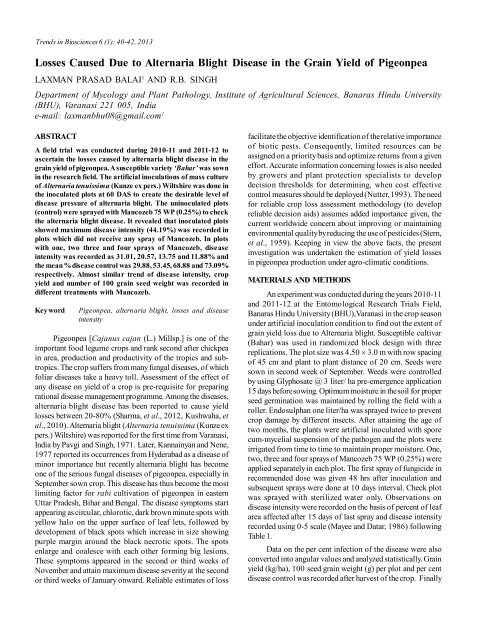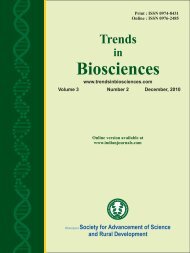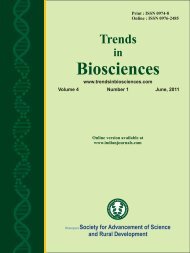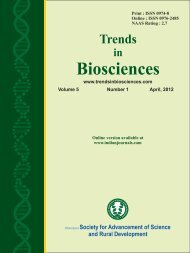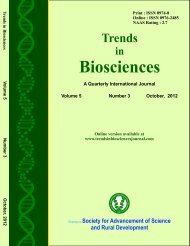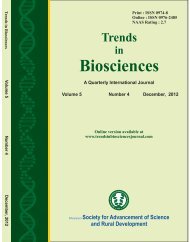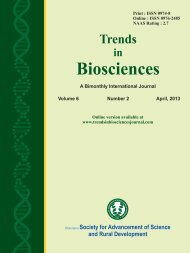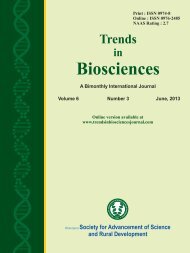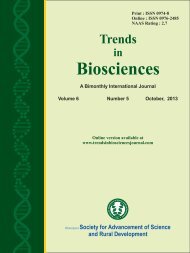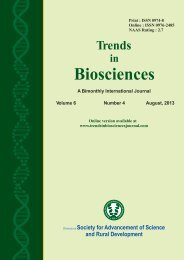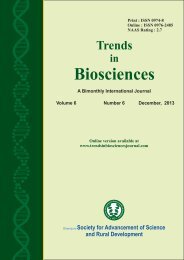TRENDS IN BIOSCIENCES 6-1, 2013 EDITION
CALL FOR RESEARCH PAPERS
CALL FOR RESEARCH PAPERS
You also want an ePaper? Increase the reach of your titles
YUMPU automatically turns print PDFs into web optimized ePapers that Google loves.
Trends in Biosciences 6 (1): 40-42, <strong>2013</strong><br />
Losses Caused Due to Alternaria Blight Disease in the Grain Yield of Pigeonpea<br />
LAXMAN PRASAD BALAI 1 AND R.B. S<strong>IN</strong>GH<br />
Department of Mycology and Plant Pathology, Institute of Agricultural Sciences, Banaras Hindu University<br />
(BHU), Varanasi 221 005, India<br />
e-mail: laxmanbhu08@gmail.com 1<br />
ABSTRACT<br />
A field trial was conducted during 2010-11 and 2011-12 to<br />
ascertain the losses caused by alternaria blight disease in the<br />
grain yield of pigeonpea. A susceptible variety ‘Bahar’ was sown<br />
in the research field. The artificial inoculations of mass culture<br />
of Alternaria tenuissima (Kunze ex pers.) Wiltshire was done in<br />
the inoculated plots at 60 DAS to create the desirable level of<br />
disease pressure of alternaria blight. The uninoculated plots<br />
(control) were sprayed with Mancozeb 75 WP (0.25%) to check<br />
the alternaria blight disease. It revealed that inoculated plots<br />
showed maximum disease intensity (44.19%) was recorded in<br />
plots which did not receive any spray of Mancozeb. In plots<br />
with one, two three and four sprays of Mancozeb, disease<br />
intensity was recorded as 31.01, 20.57, 13.75 and 11.88% and<br />
the mean % disease control was 29.88, 53.45, 68.88 and 73.09%<br />
respectively. Almost similar trend of disease intensity, crop<br />
yield and number of 100 grain seed weight was recorded in<br />
different treatments with Mancozeb.<br />
Key word<br />
Pigeonpea, alternaria blight, losses and disease<br />
intensity<br />
Pigeonpea [Cajanus cajan (L.) Millsp.] is one of the<br />
important food legume crops and rank second after chickpea<br />
in area, production and productivity of the tropics and subtropics.<br />
The crop suffers from many fungal diseases, of which<br />
foliar diseases take a heavy toll. Assessment of the effect of<br />
any disease on yield of a crop is pre-requisite for preparing<br />
rational disease management programme. Among the diseases,<br />
alternaria blight disease has been reported to cause yield<br />
losses between 20-80% (Sharma, et al., 2012, Kushwaha, et<br />
al., 2010). Alternaria blight (Alternaria tenuissima (Kunze ex<br />
pers.) Wiltshire) was reported for the first time from Varanasi,<br />
India by Pavgi and Singh, 1971. Later, Kannainyan and Nene,<br />
1977 reported its occurrences from Hyderabad as a disease of<br />
minor importance but recently alternaria blight has become<br />
one of the serious fungal diseases of pigeonpea, especially in<br />
September sown crop. This disease has thus become the most<br />
limiting factor for rabi cultivation of pigeonpea in eastern<br />
Uttar Pradesh, Bihar and Bengal. The disease symptoms start<br />
appearing as circular, chlorotic, dark brown minute spots with<br />
yellow halo on the upper surface of leaf lets, followed by<br />
development of black spots which increase in size showing<br />
purple margin around the black necrotic spots. The spots<br />
enlarge and coalesce with each other forming big lesions.<br />
These symptoms appeared in the second or third weeks of<br />
November and attain maximum disease severity at the second<br />
or third weeks of January onward. Reliable estimates of loss<br />
facilitate the objective identification of the relative importance<br />
of biotic pests. Consequently, limited resources can be<br />
assigned on a priority basis and optimize returns from a given<br />
effort. Accurate information concerning losses is also needed<br />
by growers and plant protection specialists to develop<br />
decision thresholds for determining, when cost effective<br />
control measures should be deployed (Nutter, 1993). The need<br />
for reliable crop loss assessment methodology (to develop<br />
reliable decision aids) assumes added importance given, the<br />
current worldwide concern about improving or maintaining<br />
environmental quality by reducing the use of pesticides (Stern,<br />
et al., 1959). Keeping in view the above facts, the present<br />
investigation was undertaken the estimation of yield losses<br />
in pigeonpea production under agro-climatic conditions.<br />
MATERIALS AND METHODS<br />
An experiment was conducted during the years 2010-11<br />
and 2011-12 at the Entomological Research Trials Field,<br />
Banaras Hindu University (BHU),Varanasi in the crop season<br />
under artificial inoculation condition to find out the extent of<br />
grain yield loss due to Alternaria blight. Susceptible cultivar<br />
(Bahar) was used in randomized block design with three<br />
replications. The plot size was 4.50 3.0 m with row spacing<br />
of 45 cm and plant to plant distance of 20 cm. Seeds were<br />
sown in second week of September. Weeds were controlled<br />
by using Glyphosate @ 3 liter/ ha pre-emergence application<br />
15 days before sowing. Optimum moisture in the soil for proper<br />
seed germination was maintained by rolling the field with a<br />
roller. Endosulphan one liter/ha was sprayed twice to prevent<br />
crop damage by different insects. After attaining the age of<br />
two months, the plants were artificial inoculated with spore<br />
cum-mycelial suspension of the pathogen and the plots were<br />
irrigated from time to time to maintain proper moisture. One,<br />
two, three and four sprays of Mancozeb 75 WP (0.25%) were<br />
applied separately in each plot. The first spray of fungicide in<br />
recommended dose was given 48 hrs after inoculation and<br />
subsequent sprays were done at 10 days interval. Check plot<br />
was sprayed with sterilized water only. Observations on<br />
disease intensity were recorded on the basis of percent of leaf<br />
area affected after 15 days of last spray and disease intensity<br />
recorded using 0-5 scale (Mayee and Datar, 1986) following<br />
Table 1.<br />
Data on the per cent infection of the disease were also<br />
converted into angular values and analyzed statistically. Grain<br />
yield (kg/ha), 100 seed grain weight (g) per plot and per cent<br />
disease control was recorded after harvest of the crop. Finally


